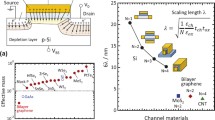Abstract
The electronic industry using silicon complementary metal-oxide-semiconductor (CMOS) technology is the leading contender in the market since five decades. Nowadays, silicon CMOS technology is reached to its fundamental limits (physical and geometrical), which is the major roadblock for upcoming technological nodes. As an alternative solution, two-dimensional (2D) materials are in great demand. Graphene is the first 2D material being studied and it is also known as “miracle-material” due to its incredible physical properties. This paper explores the current status of graphene transistor as a potential supplement to the silicon CMOS technology. The absence of an energy bandgap in graphene results in severe shortcomings for logic applications. Various techniques to engineer the bandgap in graphene field-effect transistors (FETs) have been discussed. The use of dopant atoms in graphene and its effect on drain current is studied. The current-voltage characteristics of prototype devices are determined by the first-principles quantum transport calculations. The graphene nanoribbon (GNR) FET and dual-gate (DG) FET structures have been designed and simulated using QuantumWise ATK. A bandgap opening technique in bilayer graphene is proposed and analysed for FET applications as a potential replacement for silicon transistors.
Similar content being viewed by others
References
Geim AK, Novoselov KS (2007) Nature Mater 6:183–191
Geim AK (2009) Science 324(5934):1530–1534
Chenyun P, Naeemi A (2016) IEEE Electron Device Letters 37(4):508–511
Nikonov DE, Young IA (2015) IEEE J Exploratory Solid-State Comput Devices Circuits 1(1):3–11
Soumya J, Dutta AK (2015) IEEE Trans Electron Devices 62(12):4313–432
Liao W, Zhao H, Ouyang G, Chen K-Q, Zhou G (2012) Appl Phys Lett 100:153112
Liao WH, Zhou BH, Wang HY, Zhou GH (2010) Eur Phys J B 76:463–467
Castro Neto H, Guinea F, Peres NMR, Novoselov KS, Geim AK (2009) Rev Mod Phys 81(1):109
Novoselov KS, Geim AK, Morozov SV, Jiang D, Zhang Y, Dubonos SV, Grigorieva IV, Firsov AA (2004) Science 306(5696):666–669
Berger C, Song Z, Li X, Wu X, Brown N, Naud C, Mayou D, Li T, Hass J, Marchenkov AN, Conrad EH, First PN, de Heer WA (2006) Science 312(5777):1191–1196
Lin Y-M, Dimitrakopoulos C, Jenkins KA, FArmer DB, Chiu H-Y, Grill A, Avouris Ph (2010) Science 327(5966):662
Gupta SK, Jaiswal GN (2015) Superlattice Microst 86:355– 362
Rodriguez S, Vaziri S, Smith A, Frégonèse S, Ostling M, Lemme MC, Rusu A (2014) IEEE Trans Electron Devices 61(4):1199–1207
Tamersit K, Djeffal F (2016) IEEE Sensors J. 16(11):4180–4191
Chen FW, Ilatikhameneh H, Klimeck G, Rahman Tao Chu R, Chen Z (2015) SISPAD 2015
Fahim-AI-Fattah Md, Tawabur Rahman Md, Sherajul Islam Md, Bhuiyan AG, Abdullah Khan A (2015) (ICEEICT 2015)
Taylor J, Guo H, Wang J (2001) Phys Rev B 63(24):245407–1–245407-13
Brandbyge M, Mozos JL, Ordejon P, Taylor J, Stokbro K (2002) Phys Rev B 65:165401–1–165401-17
Liu F, Liu X, Kang J (2011) Appl Phys Lett 98:213502
Kechedzhi K, Falko VI, McCann E, Altshuler BL (2007) Phys Rev Lett 98:176806
McCann E (2006) Phys Rev b (74), 161403
McCann E (2007) Phys Status Solidi B (244), 4112
Li SL, Miyazaki H, Hiura H, Liu CA, Tsukagoshi K (2011) ACS Nano 5 (500)
Minot ED, Yaish Y, Sazonova V, Park J-Y, Brink M, McEuen PL (2003) Phys Rev Lett 90:156401/1–156401/4
Zhou SY, Gweon GH, Fedorov AV, First PN, De Heer WA, Lee DH, Guinea F, Neto AHC, Lanzara A (2007) Nat Mater 6(10):770–775
Ribeiro RM, Peres NMR, Coutinho J, Briddon PR (2008) Phys Rev B 78:075442/1–075442/7
Son YW, Cohen ML, Louie SG (2006) Phys Rev Lett 97:216803
Eazwa M (2006) Phys Rev B 73:045432
Sun L, Li QX, Ren H, Su HB, Shi QW, Yang JL (2008) J Chem Phys 129:074704
Lee Y-H, Kim Y-J (2012) Appl Phys Lett 101:083102
Fu X-W, Liao Z-M, Zhou J-X, Zhou Y-B, Wu H-C, Zhang R, Jing G, Xu J, Wu X, Guo W, Yu D (2011) Appl Phys Lett 99 :213107
Son Y-W, Cohen ML, Louie SG (2006) Nature, in press
Lee H et al (2005) Phys. Rev. B 72:174431
Ezawa M (2006) Phys Rev B 73:045432
Zhou G, Duan W (2005) Nanotechnology 5:1421–1434
Brandbyge M, Mozos JL, Ordejon P, Taylor J, Stokbro K (2002) Phys Rev B 65:165401–1–165401-17
Peres NMR, Klironomos FD, Tsai S-W, Santos JR, Lopes dos Santos JMB, Castro Neto AH (2007) Europhys Lett 80:67007
Kumar A, Kumar V, Agarwal S, Basak A, Jain N, Bulusu A, Manhas SK (2014) IEEE Trans Nanotechnol 13(1):16–22
Echtermeyer TJ et al (2007) Eur Phys J -Spec Top 148:19–26
Williams JR, DiCarlo L, Marcus CM (2007) Science 317(5838):638–641
Author information
Authors and Affiliations
Corresponding author
Rights and permissions
About this article
Cite this article
Narendar, V., Gupta, S.K. & Saxena, S. First Principle Study of Doped Graphene for FET Applications. Silicon 11, 277–286 (2019). https://doi.org/10.1007/s12633-018-9852-x
Received:
Accepted:
Published:
Issue Date:
DOI: https://doi.org/10.1007/s12633-018-9852-x




